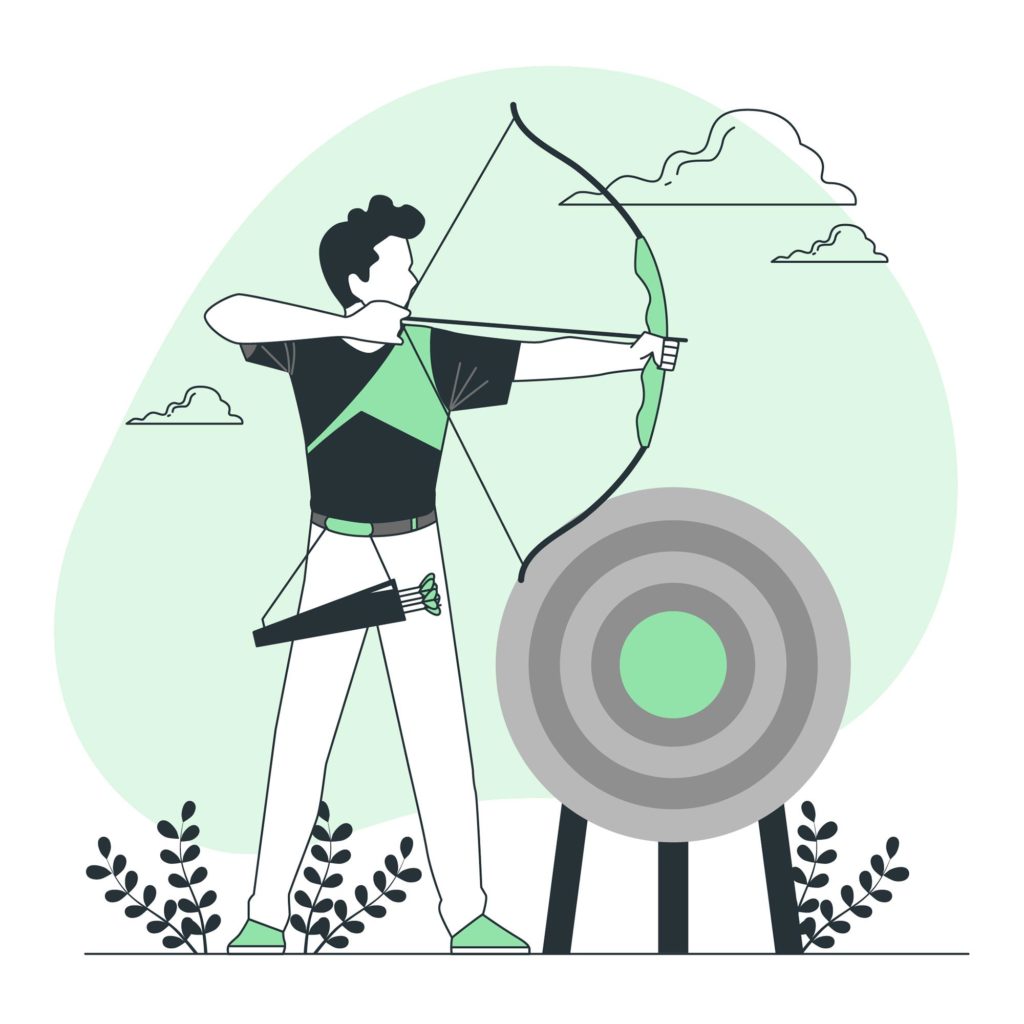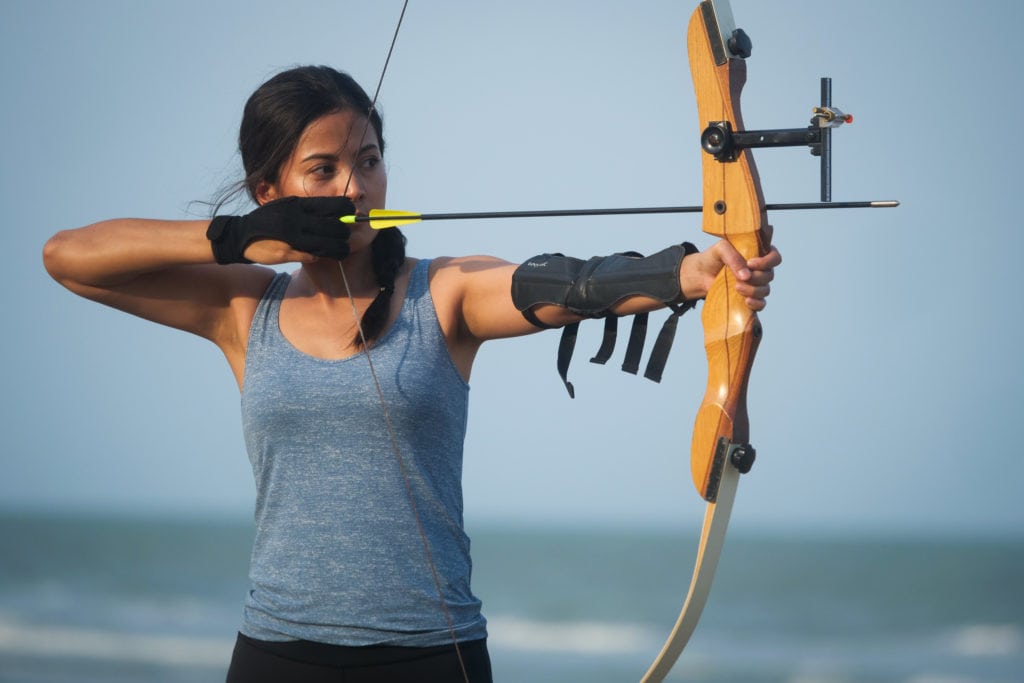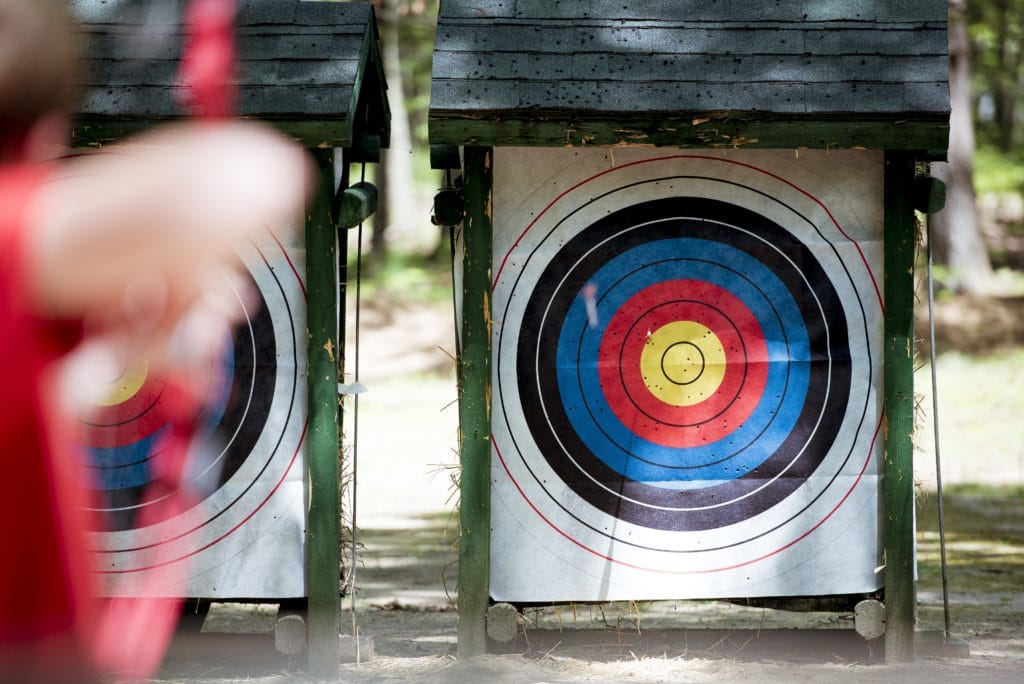Archery is a very worthwhile sport to learn. There are many archery activities you can participate in and organizations you can become a part of.
Even children can learn to properly shoot a bow and arrow. If you are an archery beginner, you may be wondering what equipment you need, how to get started, and why you should give archery a try. We will cover the topics mentioned and provide you with tools and resources to help you get the most out of your archery experience.

If you have a specific topic in mind, use our table of contents to take you where you want to go with a single click. Now, let’s get started.
Archery Basics
If you’ve never really shot a bow and arrow, it can seem both complicated and simple at the same time. It seems like anyone could do it but when you first get started, it can be difficult to figure out how to do it properly and why you’d want to do it at all.
What is Archery?
Archery involves using a bow to shoot an arrow. You may shoot at an artificial target, live animal, or even at specialized 3D objects. This sport has been around since prehistoric times and was used primarily for hunting.

A bow works kind of like a spring. An archer must pull back on the bowstring, effectively “loading” the bow with potential energy as the limbs of the bow flex. When you release the string, that energy transfers into the arrow, which sends it soaring toward your target. The more energy you front-load your bow with, the further your arrow will fly.
This sport is great for strength, focus, and competition, although it can take a bit to get the hang of it.
Types of Archery
In the past, archery was mainly used for getting food. Now a variety of activities involve a bow and arrow. Here are some common types of archery:
Target Archery
Target archery is where you shoot at a concentric target characterized by colored rings from a predetermined distance. Each color is worth a different amount of points with the center being the “bullseye” and worth the most.
This type of archery is also performed in the Olympics and requires the use of a recurve bow.

Field Archery
Field archery takes place on an outdoor course with stationary targets set at various distances. As you progress through the course, you stop at each designated spot and take your shot. This can be done alone or in teams. This is considered one of the most challenging, enjoyable forms of archery.
There is a World Field Archery Tournament held every two years and draws participants from around the world.
3D Archery
3D archery uses animal-shaped targets instead of flat, 2d versions. This can be practiced at home with a single target or can be set up field archery style to mimic bowhunting.
These targets have various areas that are marked with point values depending on the difficulty and deadliness of the shot. This is a fun way to practice in the off-season or for those who balk at shooting live animals.
Bowhunting
Bowhunting can be accomplished with a variety of bow types and is generally used with powerful broadheads. Deer, elk, hogs, wolves, and turkey are popular game for bowhunters.

Bowfishing is another form of bowhunting that involves shooting an arrow with a fishing reel attached and enables you to catch fish and reel in fish. This requires a keen eye and intense focus.
This is not an exhaustive list of types of archery but these tend to be the most popular and widely known in the United States.
Archery Equipment
There are nearly endless possibilities when getting archery equipment. Here are the main pieces of archery equipment to consider when getting started.
Bow
The bow is the single most important piece of equipment you need. There are several types of bows to choose from.
Compound Bow
A compound bow is strong, fast, and widely popular. This type of bow uses cams that rotate to help pull the string back and make the process more powerful and easier.
Recurve Bow
A recurve bow has curves in the limbs to increase the amount of energy stored, leading to more speed and energy being released. These are popular and come in Olympic, traditional, and modern varieties. You can also choose a barebow recurve which has no additional equipment to enhance your performance.
Traditional bow
Traditional bows are what comes to mind when someone says “Robin Hood bow”. They are the most basic type but have many benefits. Longbows are part of this category and are typically easy to operate.
Crossbow
A crossbow is very different in that it is held horizontally rather than vertically. These require considerable strength to pull back and use your full body strength. They are the bows with the longest range and highest accuracy and are reportedly fun to shoot.
Because the draw locks into place, you do not have to continuously hold the bowstring while waiting to release. This allows you more time to aim and focus on your target.
Arrows

An arrow is made of four basic parts. The shaft, which is the long, cylindrical part, the nock, which is a small clamp that locks onto your bowstring, the fletching which is the “feathers” on the end that keep your arrow straight as it flies, and the tip. Each part is vitally important and without the proper combination, you will have limited success.
Tips include broadheads and practice tips. Broadheads are sharp and meant to cut into your target. Practice tips do less damage but are suitable for target practice without sacrificing your good broadheads or causing undue damage to your practice targets.
Arrow shafts can be made of wood, carbon, aluminum, or composite materials and come in a variety of sizes. Your ideal type of arrow depends on the activities you will use them for.
Bolts and arrows are essentially the same thing, although bolts are generally used for crossbows.
Quiver
A quiver simply holds your arrows or bolts in an easily accessible location.
Release Aid
The release aid assists in pulling back and holding your arrow in position until you are ready to let your arrow fly. These come in index finger, thumb release, resistance activated, and finger tab/glove options.
Sight
Sights attach to your bow to help you see and zero-in on your target. These are very different from what you see on a gun. A bow sight contains a pin or pins set inside a calibrated frame to help you judge the distance to your target or the trajectory of your arrow. A peep sight attaches to your bowstring to make a hole which is used to line up your shot.
Arrow Rest
An arrow rest attaches to your bow and provides a stable platform to rest your arrow on while aiming. These are often used in conjunction with the bow sight. A good arrow rest can absorb sound, add power and stability, and protect your arrow during shooting.
Targets
If you’re going to practice, you’ll need some targets. These come in 2D and 3D versions. You can find paper targets, foam cubes, bag targets, and animal shaped options. Your choice depends on where and how often you intend to practice as well as which archery sport you are pursuing.
While there are many other archery supplies that can be helpful including rangefinders, bow hunting clothes, cases, slings, scopes, armguards, and more, those listed above will give you a great starting point.
Read Before Buying
Before you rush out and buy the first awesome bow you find, you’ll need to consider a few things.
What Size Bow Do I Need?
There are a few factors you need to take into consideration when choosing the size of your bow.
Draw Length
Draw length is how far you can comfortably pull back your bow. There are several ways to measure your draw length. No matter which you use, be sure you have an accurate measurement before making a purchase.
Draw Weight
This is the amount of force it takes to pull the bowstring back to full draw. If you are unable to pull it back far enough, your shot will have no power. If the draw weight is too light, you could damage the bow or cause injury.
Bow Length
The bow length isn’t always a significant consideration but with shorter people or children it can be necessary. If your bow is too tall relative to your (or your child’s) height, it will be harder to control and carry.

How to Choose a Bow
Now that you have an idea of how to size your bow, you need to break down the other considerations when choosing a bow.
1. What kind of bow do you want/need? Consider the purpose you will use it for and research the various types to determine the right type for you.
2. How much do you want to spend? Set a budget and stick to it. Also, keep in mind the other equipment you will need if you are just starting out.
3. Go to an archery shop. Even if you don’t plan on buying from a shop, go and try out a few bows to see what you like. Decide which grip feels right in your hand. Shoot a few practice shots to see what you think. Most shops will have an indoor range where you can take some shots.
Once you know what you want and need, it will be easier to narrow down the options online or in other stores.
Popular Archery Brands
Here are some of the top archery manufacturers. By going with a trusted name, you know the product you get will be built to last and have the features you are looking for.


● Bear Archery
● Martin
● Hoyt
● PSE
● Mathews
● Samick
● Southwest
Archery Tips
Here are some helpful archery tips to get you started.

Proper Archery Stance
The position of every part of your body affects your archery performance. Knowing the correct stance will help you have more stability, power, consistency, and control over your shots.
First, find what feels comfortable. Set up your shot and move your feet into the various stances to see what feels right to you. Once you find it, use it every time.
Next, find your anchor point. This is where your hand is positioned at full draw. This can be at your nose, cheekbone, or earlobe. Be sure this is a position you can replicate every time you draw.
Finally, adjust your posture. We are creatures of habit and if you’re used to loose shoulders, leaning forward, or tilting your head in a strange direction, that will become your default position. Straighten your body out, focus straight ahead, pull your shoulders back over your body, and set yourself up for success.
By achieving a comfortable but strong stance, you will be set up for consistent, accurate shots time after time.
For more tips and tricks, visit our Archery Tips article.
How to Shoot a Bow
Shooting a bow takes practice. Here are some steps to do it correctly every time.
1. Get into your chosen stance
2. Nock your arrow – this involves sliding the nock onto the bowstring until you hear the “click” indicating it is secure
3. Grip your bow – contrary to its moniker, you do not actually need to grip the bow tightly. Your grip is more about providing resistance and stability than holding on. Use the meaty part of your hand to press against the limb. Your fingers can be left out or lightly curled depending on what is most comfortable for you.
4. Draw your bow – pull with your dominant hand and push with your non-dominant hand to reach a full draw. Attach your release aid if one is being used.
5. Mind your posture – be sure your head is positioned forward toward your target, your back is straight, and you have a slight bend in your non-dominant arm.
6. Use your anchor point – this is the spot you draw your bowstring to. It can be your nose, ear, or cheek. You can also use a kisser button to help with this position. Have two consistent anchor points you regularly use when shooting.
7. Aim – If you are using a sight ring and a peep sight, line them up. Using a sight will help you hit your target more regularly and adjust when necessary. Warning: Never point a bow at something you don’t intend to shoot!
8. Release the arrow – this should be done in one seamless motion and should not require much movement. Watch the shot as it hits and do not relax or lower the bow until the follow-through is complete.
By practicing these tips, you can get more consistent and become a better archer. Note: Do not practice by dry firing. This can cause damage to your bow, as the stored energy has nowhere to transfer, which can weaken the limbs of your bow. Below is a helpful video of these steps.
Where to Practice Archery
We told you practice makes you a better archer, but where can you practice? If you don’t have a giant backyard or open space suitable for practice, how can you hone your archery skills? Here are a few suggestions:
Local Archery Shops
Archery shops often have a range attached either indoors or outdoors so that patrons can practice and try out their gear. There may be a charge for this, but it’s well worth it.
Archery Clubs
Join an archery club! Clubs will have setups for practice and you can also get together with others who enjoy the sport. It also gives you the opportunity to learn from one another.

Local Schools and Universities
Your high school or university might have an archery team or club and you can either join or ask how to gain access to using the facilities to practice.
Public Shooting Lands
Many public lands allow you to practice with minimal cost. Some have a park entry fee and others might cost a bit more. This is worth looking into. Just be sure to remain visible and follow all safety precautions to protect yourself and others.
Set Up a Backyard Archery Range

● If you have a good-sized backyard, you can create your own range.
● First check with laws in your city, state, and county for rules, regulations, and ordinances.
● Create your layout and accurately measure distances.
● Setup your targets.
● Add a backstop – this prevents damage to the surrounding area and people who may be nearby if you miss a shot.
Once everything is ready, you can begin practicing. Consistency and proper form are vital to making the shot and becoming a better archer.
Conclusion
As you can see, there are many applications for archery. You may be a complete beginner to the sport and just looking for the basics. If you’re a more experienced archer looking for supplies to up your game, check out these articles on bowstring wax, silencers, and stabilizers.

If you find you are having trouble with the strength you need to shoot a bow, there are many exercises you can do to help build muscles and dexterity. We also have a great article on common archery mistakes. No matter where you are on your archery journey, we hoped you found some helpful information here. Thanks for reading!

Big Game Logic is a participant in the Amazon Services LLC Associates Program, an affiliate advertising program designed to provide a means for us to earn fees by linking to Amazon.com and affiliated sites. Pages on this site may include affiliate links to Amazon and its affiliate sites on which the owner of this website will make a referral commission
